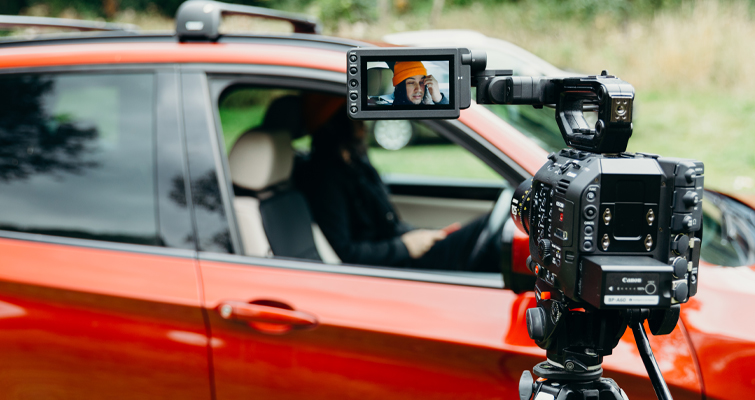How to Fix a Stuck Pixel on the Canon C300 Mk III
Here are a few quick tips on fixing a stuck pixel on your Canon C300 Mk III. It will totally save your day.
In the summer of 2011, I was shooting what I thought would be my magnum opus, “Grim: A Tale of Death.” I’m not sure why it would be a magnum opus considering it would be my first piece of visual work uploaded to the internet. But, I was twenty years old and slightly arrogant.
That said, I was quickly humbled while filming one day when I noticed a bright pink dot on the LCD screen of the 5D Mk II . . . then another . . . and one more.
“What on earth is this?”
We quickly popped the CF card into the laptop we had, and it showed up on the footage. After several minutes of frantic Googling—what Googling we could do back on 2011 Blackberries—it was apparent I had a hot pixel.
“#!@*.”
I’ve previously covered what a hot pixel is and how to fix one in this article, and if you’re unsure as to what a hot pixel is:
A hot pixel is a common defect found in the majority of digital cameras. You’ll often find hot pixels in your image during a long exposure shot with a high ISO. It’s normal to have these, and they will come and go over time.
Hot pixels (in a photograph) aren’t a problem. You can fix the image very quickly in Lightroom or Photoshop. These are caused by electrical charges that leak into the sensor wells, and they will get worse and appear more frequently when the sensor itself is hot.
Typically, these are only found upon inspection of the image in post-production. It’s very rare for a hot pixel to show up on your camera’s LCD screen.
– Lewis McGregor
And, in most circumstances, when stuck with a hot pixel with video, there’s little that can be done.

An Expensive Hot Pixel
Recently, I was filming a PremiumBeat recording session at Abbey Road Studios (you’ll likely see this on our social media in the coming weeks), and during the recording, I noticed a pink dot on the LCD. And, once again, uttered “#!@*” but this time within my mind as the orchestra was currently playing.
I felt sick in the pit of my stomach as this was not a hot pixel on a second-hand 5D Mk II, but a hot pixel on the expensive C300 Mk III. And, while under warranty, the thought about having to send it off to have the sensor replaced made me feel giddy.
However, vivid images of bandits ransacking the postal van like a western stagecoach were enough to know I’d be trying every home fix before sending the camera to CPS.

Upon returning home, I ran a few tests and the hot pink pixel was still present. Interestingly, however, when I imported the media, the pixel was there, but not pink. It was a light green. This presented an interesting issue.
See, hot pixels are named as such because of the bright, hot nature of their appearance. So, for it to not appear as hot, but green, suggested it was a stuck pixel. Unlike hot pixels, stuck pixels do receive information and power, just not the correct information. They’ll usually appear as a color from the RGB color model, such as a bright green.
At this point of the night, I had the “light bulb” moment (or, actually, a “you idiot” moment). See, I like to shoot with red focus peaking. As a result, the camera detecting the pixel was showing as a red dot, not because it was a hot pixel, but because the focus edges of stuck pixel and rendering it a red outline. Upon turning the peaking off, it was no longer visible—to a degree.
How to Remove Stuck Pixel
While the pixel was no longer detectable on the monitor, it was ultimately still present within the media when viewed on the desktop. Therefore, there was still an issue, just perhaps not one as intense as a hot pixel.
If you’ve found a red, green, or blue pixel within your image, thankfully, this is an easy fix. In the trusty C300 Mk III manual, it states:
Try adjusting the black balance. The camera’s CMOS sensor is a delicate piece of precision engineering. Direct exposure of the sensor to ion rays or other cosmic radiation may affect it and may rarely appear as bright-colored dots on the screen. This is the nature of CMOS image sensors and does not represent a malfunction.
– Canon C300 Mk III Manual
And, of course, just like digital noise, the issue is more prevalent when filming at higher ISOs, or with a slower shutter speed (presumably for creative effect).
Now, to adjust the black balance, you need to remove the lens, attach the body cap to the lens mount, and set the camera to CAMERA mode. Then head to: MENU > [🎥 Camera Setup] > [ABB] > [OK].
The automatic black balance procedure will start, and will take around one minute. Just lay the camera down and let it do its thing. When the confirmation message appears, press SET.
If the sensor isn’t completely shielded from the light, [Error] will appear on the screen. Repeat the procedure from the beginning.

If the pixel that was present on your image was red, green, or blue, it should now be removed. If it’s still a persistent hot pink, you’ll need to send the camera to Canon Professional Services.
As a sidenote, adjusting the black balance is necessary in the following cases:
- When using the camera for the first time or after a long period of not using it.
- After sudden or extreme changes in ambient temperature.
- After changing in the sensor mode.
- After activating or deactivating slow & fast motion recording (including switching to another special recording mode).
- After changing the shooting frame rate.
- After resetting the camera’s settings.
During the adjustment of the black balance, you may notice some irregular displays appear on the screen. This is not a malfunction.
For more articles on Canon-related gear, take a look at these:





